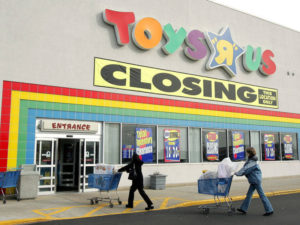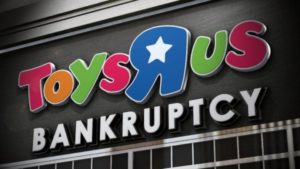 Toys R Us, the iconic toy store chain with more than 700 stores across the U.S., announced on Thursday, March 15, that it would go out of business after a failed rescue effort. The company, saddled with debt in part due to a very bad business decision involving Bain Capital, had planned to only shutter the least-performing locations to try to build back market strength. However, missed debt payments and the lack of white knight investors late in negotiations spelled out the final step for Geoffrey the Giraffe.
Toys R Us, the iconic toy store chain with more than 700 stores across the U.S., announced on Thursday, March 15, that it would go out of business after a failed rescue effort. The company, saddled with debt in part due to a very bad business decision involving Bain Capital, had planned to only shutter the least-performing locations to try to build back market strength. However, missed debt payments and the lack of white knight investors late in negotiations spelled out the final step for Geoffrey the Giraffe.
From Pitchbook.com:
Then there is Toys R Us, the brick-and-mortar children’s toys retailer that announced Wednesday it would begin winding down all 735 US locations, more than a decade after Bain Capital, KKR and Vornado Realty Trust sunk a reported $1.3 billion into a $6.6 billion take-private deal in 2005. The company, which officially withdrew its IPO plans in 2013, has struggled to pay off the roughly $5 billion in debt since the buyout. Meanwhile, the original investor group earned a reported $470 million in management and interest fees during its ownership tenure, though the consortium also invested $3.5 billion into the business over that same period.
With sales lagging and competition from the likes Walmart and Amazon, Toys R Us filed for Chapter 11 bankruptcy this past September, with Bain Capital and its fellow co-investors exiting. At the time, the company reportedly planned to invest $400 million it gained from bankruptcy loans in an experiential shopping format that would allow kids to play at the stores. Now, under the guidance of lenders, the company has begun discussions to combine 200 of its top-performing U.S. locales with its Canadian operations.
I want to push back against what will ultimately be the post-mortem all the major media outlets will present, that it was primarily Amazon’s fault that Toys R Us is going under. Amazon played an outsized role in the demise and Bain Capital’s influence which, to many, will look no less than predatory, also weighs heavily in the whys-and-wherefores.
But much of this ignores the responsibility of the entity for its own demise, and yes, Toys R Us needs to bear some of that burden, too.
Let’s not fool ourselves: children do not buy toys. Parents buy toys for children, and the decision of where to buy those toys conclusively rests with the adults. However, children can heavily influence that decision.
When I was a kid, back when life first emerged from the primordial ooze, toys stores were more than shopping meccas. They were also destinations, and the children who came to such places would be met with color and sound, great displays, and goods in action and demonstration. A Toys R Us near me once set up racing and train sets, had the occasional drop-in of people in character suits, and around Christmastime had their own Santa Claus set-up. In short, the stores positioned themselves as experiential, not merely commercial. They were more than a store.
 Much of this glamor went away in the early-1990s with the influx of video game systems. Initially, toy stores were one of the few places where you could find new NES games, Sega systems and, later, Super Nintendo games. The video game specialization stores (and yes, online buying as well as downloading) weren’t a dominant force yet. Nonetheless, presuming they had a lock on a commodity, many toy stores – not just Toys R Us – got rid of the trappings of the experience of buying toys. It was as if all these company CEOs made a mass decision: “We don’t need to make these brick-and-mortar shops interesting anymore. We got ’em.”
Much of this glamor went away in the early-1990s with the influx of video game systems. Initially, toy stores were one of the few places where you could find new NES games, Sega systems and, later, Super Nintendo games. The video game specialization stores (and yes, online buying as well as downloading) weren’t a dominant force yet. Nonetheless, presuming they had a lock on a commodity, many toy stores – not just Toys R Us – got rid of the trappings of the experience of buying toys. It was as if all these company CEOs made a mass decision: “We don’t need to make these brick-and-mortar shops interesting anymore. We got ’em.”
You can see this same mindset play out in the many shopping malls across America, a majority of which have shut down or turned into dusty, cadaverous shadows of themselves. If you go into a functional mall these days, specifically around holiday time, what will you find? Row after row of clothing stores, maybe a hair salon, and always an eyeglass kiosk. The toy store chain Kay Bee Toys exited the scene years ago. Music stores closed with the demise of the vinyl record and the cassette which, to the amazement of many, resurfaced as luxury items. Stores like Hot Topic and Urban Outfitters also sell music but are mainly known for clothing. Several malls had more than one bookstore, but in most malls now if there’s a bookstore at all, it’s a solitary Barnes & Noble. Even though Amazon is the undisputed champion of book sales in physical and digital form, Barnes & Noble is still ekeing out an existence. The food court in most malls is a melange of dominant fast food chains you can find anywhere and slightly scary entrepreneurial efforts you really hope to never find at all.
In other words, malls turned into gigantic clothing outlets, boring and rather uncomfortable to traverse. But remember when I mentioned “holiday time.” Again, when I was a kid, malls, toy stores, stores, in general, went all out to decorate, to provide experiences, and to be interesting. Those same toy stores came to life with color, light, and sound. In the malls, one could find massive, life-sized dioramas depicting scenes from beloved Christmas stories. There were specialty food shops, and very often they handed out samples of, for example, Hickory Farms meats and cheeses. There was something much like a Cinnabon shop (before the advent of Cinnabon) which handed out mini-rolls, and yes, all of this cost money. But if you speak to those who were involved in brick-and-mortar shops back then, that money was an investment. It helped imprint the stores on the minds of consumers.
Why? Because these times of the year, and these efforts, created goodwill, and these efforts were well-contained to the last week of November into December and did not contribute to the sprawl we now see where Christmas encroachment begins in the middle of August. By conserving their firepower, such stores ingratiated themselves to the customers and did not offend with the blatant coarseness of commercialism.
 This is what we see today: all the Christmas stuff comes out on the shelves before Labor Day. Some tinsel and garland get hung, along with a couple of wreaths. Mostly, you get a lot of red, white, and green signage of the “ho, ho, ho, buy, buy, buy” variety. All the effort is there to make you buy stuff, but very little effort is expended to make you feel anything.
This is what we see today: all the Christmas stuff comes out on the shelves before Labor Day. Some tinsel and garland get hung, along with a couple of wreaths. Mostly, you get a lot of red, white, and green signage of the “ho, ho, ho, buy, buy, buy” variety. All the effort is there to make you buy stuff, but very little effort is expended to make you feel anything.
That brings us to today. You can buy anything online. You probably will, unless you absolutely need it immediately. A physical store must be more than a place that resolves a purchasing emergency. You have to want to go there. You have to experience something while being there, something that triggers the brain to release more of those good pleasure chemicals than hitting the “send” button from your PayPal account will. Not many places bother. They are sticking with the functional model of filling shelves and praying, and is it any wonder people have gotten sick of going to such boring, dreadful places?
Toys R Us should never have become a “boring, dreadful place,” but they did. They became aisle after aisle of merchandise just slightly out of reach of their target audience. They became much like a grocery store. Whoopee. They sucked all the “experience” out of going there, and so it was that the kids seldom asked to go (or nagged to go, which would have been more the case). In among the larger factors of Bain Capital’s vampiric effects and Amazon’s siphoning off the wallet-holder thanks to convenience, Toys R Us alienated its target audience.
And so, with the final roll of the Monopoly dice turning up snake-eyes, the chain follows in the sad footsteps of the previously mentioned Kay Bee, Child World, Playworld, and may soon be followed after by the remnants of Sears and K-Mart, and a nation of shopping malls reduced to less than flea markets. There are plenty of factors and culpable parties, but we should not easily forget that many of the seeds Toys R Us’ demise came when they chose to just be a store.





Comments